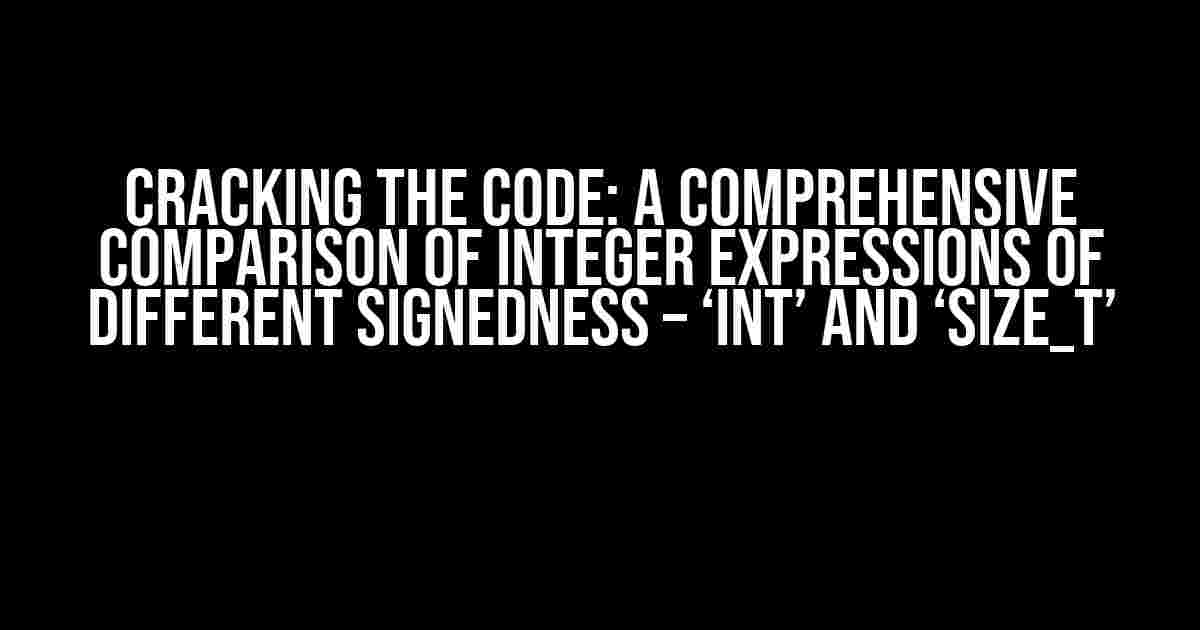When working with integers in programming, it’s essential to understand the distinction between ‘int’ and ‘size_t’ data types. These two types may seem interchangeable, but they have distinct characteristics that can significantly impact the behavior of your program. In this article, we’ll delve into the world of integer expressions, exploring the comparison of ‘int’ and ‘size_t’ and providing you with the knowledge to make informed decisions in your coding endeavors.
What is ‘int’?
The ‘int’ data type is a fundamental building block in programming, representing a signed integer that can hold both positive and negative values. It’s a 32-bit data type, meaning it can store values ranging from -2,147,483,648 to 2,147,483,647. You can think of ‘int’ as a versatile type that can be used in a wide range of scenarios, from simple counters to complex arithmetic operations.
int x = 5; // declare an integer variable 'x' with value 5
int y = -3; // declare an integer variable 'y' with value -3
What is ‘size_t’?
In contrast, ‘size_t’ is an unsigned integer type, specifically designed to hold the size of an object or the number of elements in an array. It’s an alias for one of the unsigned integer types, usually ‘unsigned int’ or ‘unsigned long int’, depending on the platform. ‘size_t’ is guaranteed to be large enough to hold the size of any object, making it an excellent choice for indexing and array manipulation.
size_t arrSize = 10; // declare a size_t variable 'arrSize' with value 10
Comparison of ‘int’ and ‘size_t’
Now that we’ve covered the basics, let’s dive into the meat of the matter – comparing ‘int’ and ‘size_t’. Here are some key differences to keep in mind:
- Signed vs. Unsigned: The most obvious difference is that ‘int’ is a signed type, whereas ‘size_t’ is unsigned. This means ‘int’ can hold negative values, while ‘size_t’ can only hold positive values and zero.
- Range: The range of values for ‘int’ is much larger than ‘size_t’, which is limited to the maximum size of an object or array.
- Use Cases: ‘int’ is a general-purpose type, suitable for most integer-based operations. ‘size_t’, on the other hand, is specifically designed for size-related calculations and indexing.
- Compatibility: When mixing ‘int’ and ‘size_t’ in expressions, the signedness of ‘int’ can lead to unexpected results, especially when dealing with negative values.
Performing Operations with ‘int’ and ‘size_t’
When combining ‘int’ and ‘size_t’ in expressions, it’s essential to understand how the compiler will handle the operations. Here are some examples:
int x = 5;
size_t y = 10;
// Example 1: Addition
int sum = x + y; // implicit conversion of y to int
// Example 2: Comparison
bool isEqual = x == y; // comparison between signed and unsigned types
In the first example, the compiler will implicitly convert the ‘size_t’ value to an ‘int’, which can lead to unexpected results if the value is too large to fit in an ‘int’. In the second example, the comparison between a signed and unsigned type can produce confusing results, especially when dealing with negative values.
Pitfalls and Best Practices
To avoid common pitfalls when working with ‘int’ and ‘size_t’, follow these best practices:
- Use ‘size_t’ for size-related calculations: ‘size_t’ is specifically designed for this purpose, ensuring you get the correct results.
- Avoid mixing signed and unsigned types: When possible, stick to a single type throughout your expression to avoid implicit conversions and unexpected results.
- Be mindful of overflow and underflow: When performing arithmetic operations, ensure you’re not exceeding the maximum or minimum values for the respective type.
- Use explicit casting: If you must mix types, use explicit casting to ensure you’re aware of the implications and can handle any potential issues.
Real-World Examples
Now that we’ve covered the theory, let’s look at some real-world examples to solidify our understanding:
| Example | Code | Result | Explanation |
|---|---|---|---|
| Array Indexing | int arr[5]; size_t idx = 3; arr[idx] = 10; |
Valid |
‘size_t’ is used for indexing, ensuring a valid array access. |
| Negative Value Comparison | int x = -5; size_t y = 10; bool isEqual = x == y; |
False (Unexpected Result) |
The comparison between signed and unsigned types can produce unexpected results. |
| Explicit Casting | int x = 5; size_t y = 10; int sum = (int)y + x; |
Valid |
Explicit casting ensures a correct result, avoiding implicit conversions. |
Conclusion
In conclusion, understanding the differences between ‘int’ and ‘size_t’ is crucial for writing efficient, reliable, and maintainable code. By following best practices and being mindful of the implications of mixing signed and unsigned types, you can ensure your programs behave as intended. Remember, it’s always better to be explicit and aware of the types you’re working with, rather than leaving it to chance.
As you embark on your coding journey, keep in mind the wisdom of Donald Knuth: “The most important thing in the programming language is the name. A language will not succeed without a good name. I have recently invented a very good name and I’m looking for a language.”
Now, go forth and conquer the world of integer expressions, armed with the knowledge of ‘int’ and ‘size_t’!
Frequently Asked Question
Are you puzzled about comparing integer expressions with different signedness, specifically ‘int’ and ‘size_t’? Don’t worry, we’ve got you covered! Here are some frequently asked questions and answers to clarify any doubts you may have:
What happens when I compare an ‘int’ with a ‘size_t’?
When you compare an ‘int’ with a ‘size_t’, the compiler promotes the ‘int’ to an unsigned type, which can lead to unexpected results if the ‘int’ value is negative. This is because ‘size_t’ is an unsigned type, and the comparison will be performed as if the ‘int’ value were unsigned as well.
Why do I get a warning when comparing a signed integer with an unsigned integer?
The warning is because the comparison between a signed integer (like ‘int’) and an unsigned integer (like ‘size_t’) can lead to unexpected behavior, as mentioned earlier. The compiler is alerting you to this potential issue, so you can take steps to ensure the comparison is performed correctly.
How can I avoid unexpected results when comparing ‘int’ and ‘size_t’?
To avoid unexpected results, you can cast the ‘size_t’ value to a signed integer type, like ‘int’ or ‘ssize_t’, before performing the comparison. This ensures the comparison is performed correctly, considering the signedness of the values.
What is the difference between ‘int’ and ‘size_t’?
The main difference between ‘int’ and ‘size_t’ is that ‘int’ is a signed integer type, which can represent both positive and negative values, whereas ‘size_t’ is an unsigned integer type, which can only represent non-negative values. ‘size_t’ is typically used to represent sizes, counts, or indices, and is guaranteed to be large enough to hold the size of any object.
Are there any best practices for using ‘int’ and ‘size_t’ in my code?
Yes, a good practice is to use ‘size_t’ for variables that represent sizes, counts, or indices, and ‘int’ for variables that represent general-purpose integer values. Be cautious when comparing or assigning ‘int’ values to ‘size_t’ variables, and consider casting or explicit type conversions to ensure correct behavior.



